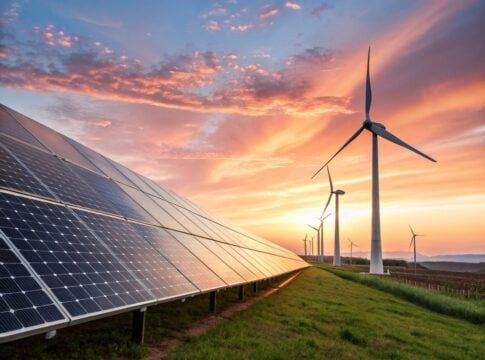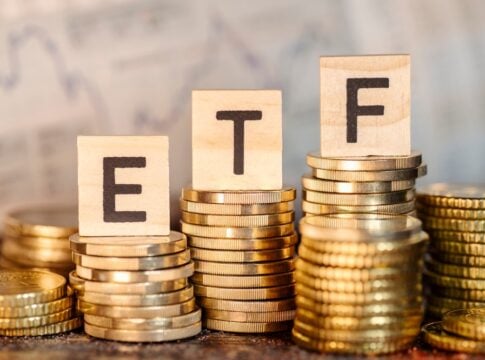Visa and Mastercard, processing billions of payment transactions yearly, reported strong financial growth in 2025, driven by rising payment volumes and cross-border transactions. However, their massive operations generate significant carbon emissions, pushing them to adopt sustainability and net zero strategies.
Strong Numbers, Stronger Strategy: Visa’s Q1 2025 Performance
Visa reported strong Q1 2025 results, with net revenue rising 10% year-over-year (YoY) to $9.5 billion. Net income also increased 5% to $5.1 billion, while GAAP earnings per share (EPS) grew 8% to $2.58 and non-GAAP EPS stood at $2.75. Visa’s board declared a quarterly cash dividend of $0.59 per share.

The company attributed its growth to strong consumer spending, a rise in payment volume, and an increase in cross-border transactions. CEO Ryan McInerney highlighted three major growth drivers:
- Consumer payments,
- New payment flows, and
- Value-added services.
These areas continue to expand as Visa strengthens its global network.
A key move during the quarter was Visa’s acquisition of Featurespace, an artificial intelligence-powered fraud protection firm. This acquisition aligns with Visa’s long-term goal of enhancing transaction security.
While Visa continues to grow, its expenses are also increasing, particularly in research and development. However, its strong revenue growth has helped maintain profitability and reinforce its position as a leader in the payments industry.
Mastering Growth: How Mastercard Outpaced Expectations
Mastercard posted strong 2024 results, with net revenue increasing 12% YoY to $28.2 billion, beating market expectations. Adjusted EPS grew 19% to $14.60, exceeding analyst estimates. Its adjusted operating margin improved slightly to 58.4%.
In Q4 2024, Mastercard’s gross dollar volume reached $2.6 trillion, up 12% YoY. Cross-border volumes, a key revenue driver, rose 20%, while switched transactions increased 11% to 42.2 billion. The company’s value-added services generated $3.1 billion in revenue, up 16%.
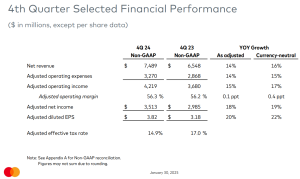
Mastercard’s value-added services and solutions business also played a critical role in its financial performance. Net revenue from these services reached $3.1 billion, a 16% YoY increase, driven by demand for security, digital authentication, and market insights.
Unlike Visa, Mastercard experienced a sharper increase in operating expenses, which climbed by 14% YoY to $3.3 billion. The rise was mainly due to higher general and administrative costs. However, adjusted operating income still grew by 15% YoY to $4.22 billion.
Both Visa and Mastercard reported strong financial growth, but Mastercard outpaced Visa in revenue, EPS growth, and transaction volume. Visa focused on operational efficiency and security investments, while Mastercard’s cross-border transactions and value-added services drove its growth.
A Green Rivalry: Who’s Leading the Sustainability and Net Zero Race?
Despite rising expenses, both companies remain leaders in the global payments industry. However, their massive operations with billions of transactions processed annually generate carbon emissions, prompting them to reduce their environmental footprint. While they share common goals, their sustainability and net zero approaches differ.
Swiping Towards Sustainability: Visa’s Carbon Goals and Green Investments
Visa aims to reach net-zero emissions by 2040, aligning with the Paris Agreement’s 1.5°C pathway. It has been carbon neutral in its operations since 2020, achieving this by reducing direct greenhouse gas (GHG) emissions and purchasing carbon offsets. The company sources 100% renewable electricity for its offices and data centers, significantly cutting GHG emissions.
Visa has made notable strides in reducing its operational emissions, particularly in Scope 1 and 2 emissions, which saw a downward trend from 2009 to 2022. However, in 2023, Scope 1 and 2 emissions increased from 6,400 to 10,600 metric tons of CO2 equivalent, primarily due to a slight uptick in Scope 2 emissions, rising from zero in 2022 to 300 metric tons.
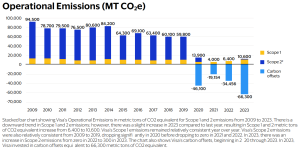
Despite this, Visa continues to offset its emissions significantly toward net zero. The payment processor has invested in carbon offsets equivalent to 66,300 metric tons of CO2 in 2023.
In terms of Scope 3 emissions, Visa experienced a slight rise in 2023, reaching 409,500 metric tons of CO2 equivalent. This is driven mainly by increases in employee commuting and business travel, while emissions from purchased goods and services saw a small decrease.
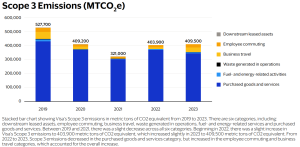
Carbon Offsets, Green Finance, and Climate Tech Solutions
Visa invests in renewable energy projects and high-quality carbon offset programs. The company supports global reforestation initiatives and clean energy transition projects.
In 2023, Visa’s environmental investments helped mitigate the equivalent of 400,000 metric tons of CO2 emissions.
The payment processor’s sustainability efforts extend to financial products. Visa has partnered with fintech firms to introduce carbon footprint tracking tools for consumers.
Through the Visa Eco Benefits program, banks can offer sustainability-focused rewards and carbon offset options. Additionally, Visa has worked with financial institutions to issue over 20 million eco-friendly payment cards made from recycled materials or biodegradable alternatives.
Furthermore, Visa is integrating sustainability into mobility and payment solutions. The company supports contactless payments for public transit to reduce reliance on cash and has collaborated with EV charging networks to streamline payments.
The company is also investing in climate-focused fintech startups that develop solutions for carbon tracking and sustainable finance. However, compared to its competitor, its indirect emissions strategy is less aggressive.
Priceless Progress: Mastercard’s Commitment to a Net-Zero Future
Mastercard has been carbon neutral in its operations since 2021 and aims to reach net-zero emissions by 2040. Like Visa, it sources 100% renewable electricity for its offices and data centers.
Mastercard has made significant progress in reducing its GHG emissions as part of its commitment to environmental sustainability. In 2023, the company achieved a 1% reduction in total emissions, totaling 557,545 metric tons of CO2 equivalent across Scope 1, 2, and 3.
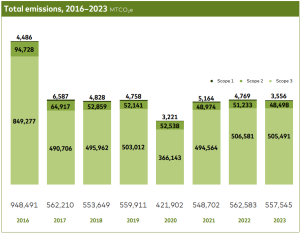
Notably, its Scope 1 and 2 emissions, which account for 9% of total GHG emissions, decreased by 7%, producing 52,054 metric tons of CO2 equivalent. These emissions have declined significantly, 48%, from its 2016 baseline.
For Scope 3 emissions, which make up 78% of the company’s total emissions, Mastercard saw a 3% reduction in its supply chain emissions in 2023, totaling 437,588 metric tons of CO2 equivalent.
The payment processor remains on track to meet its 2025 targets of reducing Scope 1 and 2 emissions by 38% and Scope 3 emissions by 20% compared to 2016 levels.
Mastercard‘s Scope 3 emissions came from indirect sources, primarily from its financial partners and supply chain. To address this, the company has integrated sustainability criteria into its vendor selection process and encourages its banking partners to reduce their own carbon footprints.
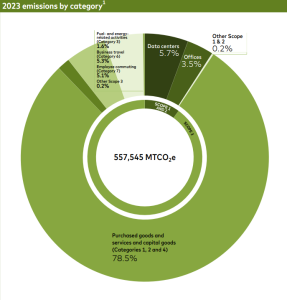
Mastercard’s Green Finance and Reforestation Efforts
Mastercard takes a different approach to carbon offsets and net zero from Visa. The company launched the Priceless Planet Coalition, a global reforestation initiative aiming to restore 100 million trees by 2025.
Through this initiative, Mastercard has already funded the planting of 60 million trees across 20 countries, aiming to remove approximately 10 million metric tons of CO2 from the atmosphere by 2030.

Mastercard has also taken the lead in sustainable financial tools. The Mastercard Carbon Calculator, developed with Doconomy, allows consumers to track the carbon footprint of their purchases directly within their banking apps. Over 50 banks worldwide have integrated this tool, helping millions of users make informed spending decisions.
Additionally, Mastercard has expanded its ESG-linked financial products, including green bonds and sustainability-focused credit cards. In 2023, the company supported the issuance of $500 million in ESG-linked financial products, reinforcing its commitment to sustainable finance.
Mastercard is also investing in climate technology and EV infrastructure. It has partnered with global EV charging networks to streamline payment processes and promote wider EV adoption. The company is also funding fintech startups that focus on climate risk management and sustainable investment platforms.
Visa vs. Mastercard: Who Leads in Sustainability?
Both Visa and Mastercard are making significant strides in financials and net zero. They both have achieved carbon neutrality in their operations, but Mastercard appears to have a more comprehensive and aggressive approach.
By integrating sustainability into financial products, investing in large-scale reforestation, and actively reducing indirect emissions, Mastercard sets a higher standard in climate action. Visa, on the other hand, excels in operational efficiency and renewable energy adoption but may need to expand its influence over its financial network to achieve a more substantial impact.
The post Visa vs. Mastercard: Who’s Leading the Charge in Finance, Sustainability, and Net Zero? appeared first on Carbon Credits.
Carbon Footprint
Renewables 2025: How China, the US, Europe, and India Are Leading the World’s Clean Energy Growth
The world’s renewable energy sector has entered a new phase of record growth. According to the International Energy Agency’s Renewables 2025 report, global renewable power capacity grew by more than 510 gigawatts (GW) in 2024 — the fastest increase ever recorded. Another 520 GW is expected to be added in 2025, pushing renewables to account for over 90% of all new global power capacity.
Solar and wind dominate this growth. By 2025, solar will account for nearly three-quarters of new installations. This growth comes from cheaper technology, improved grid integration, and supportive policies. Wind power is also recovering after a slowdown in 2022–2023, supported by new offshore projects in Europe, China, and the United States.
The IEA says the world’s total renewable capacity will reach nearly 5,800 GW by 2025, up from around 4,200 GW in 2023. That means renewables now generate about 30% of global electricity and are on track to reach 42–45% by 2030.
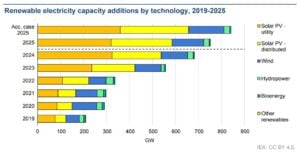
Four regions — China, Europe, the United States, and India — are responsible for almost 90% of this global expansion. Each is moving at a different pace, but together they are transforming how the world produces and consumes energy.
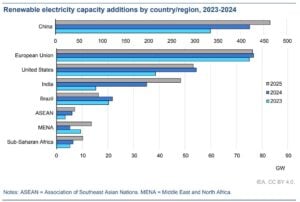
Europe: Accelerating the Energy Transition
Europe continues to lead in energy policy and innovation. In 2024, the European Union added more than 70 GW of new renewable capacity, driven mainly by solar. This is a record year. It shows the bloc’s goal to cut reliance on imported fossil fuels. They aim to meet their Green Deal target of a 55% emissions reduction by 2030.
Solar capacity across the EU doubled between 2020 and 2024, reaching over 300 GW, while wind capacity passed 220 GW. The IEA predicts that Europe will add 450 GW of renewables from 2025 to 2030. This will raise the total capacity to almost 870 GW by the end of the decade.

Much of this growth is tied to the REPowerEU plan, which aims to speed up permitting and expand rooftop solar. Offshore wind is gaining popularity. Countries like Germany, Denmark, and the Netherlands are investing in North Sea projects.
Despite progress, Europe faces challenges. Delays in grid expansion and limited local manufacturing capacity for wind turbines have created supply bottlenecks. Even so, strong policy support and high carbon prices still make renewables the best choice for power generation.
United States: Policy Support and Private Investment Drive Expansion
The United States is entering a period of major renewable growth, supported by the Inflation Reduction Act (IRA) and record private investment. The IEA expects the U.S. to add around 400 GW of new renewable capacity by 2030, effectively doubling its current base.
In 2024, U.S. solar installations rose by nearly 40%, reaching 45 GW for the year. Solar now accounts for the largest share of new capacity additions. Wind power also recovered, with onshore and offshore projects expanding in Texas, California, and along the East Coast.
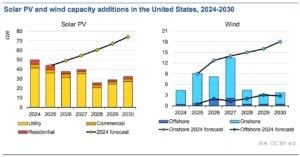
Renewables currently generate about 26% of U.S. electricity, up from 22% in 2022. The IEA projects this share will climb to over 40% by 2030, driven by federal tax incentives and falling technology costs.
Battery storage is another fast-growing sector. Storage capacity doubled between 2023 and 2024, helping stabilize variable solar and wind output. The IRA’s clean energy credits could draw over $400 billion in investments by 2032. This boost will help generate energy and support U.S. manufacturing of solar panels and turbines.
Challenges remain. The U.S. needs to modernize its grid and streamline permitting for transmission lines to connect renewable projects to demand centers. But the direction is clear — renewables are becoming the backbone of America’s energy system.
China: The Global Powerhouse of Renewables
China remains the undisputed leader in renewable energy growth. The IEA projects that China will account for about 60% of all new renewable capacity added worldwide by 2030.
In 2024 alone, China installed more than 260 GW of new renewables — more than the rest of the world combined. Solar made up the majority of this, with over 190 GW of solar capacity added during the year.
Wind power grew by 60 GW. China kept building big onshore and offshore projects in Inner Mongolia, coastal areas, and deserts.
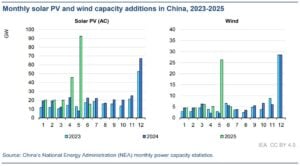
China now has an estimated 1,400 GW of total renewable capacity, representing about half of the global total. Renewables already supply more than 35% of China’s electricity, up from 27% in 2020.
Government policy is the key driver. China aims to reach 1,200 GW of combined solar and wind capacity by 2030, a target it is likely to achieve five years early. The country’s large manufacturing base keeps equipment prices low globally. This helps other regions grow their clean energy fleets.
Still, integration challenges persist. Some provinces face grid congestion and curtailment — when renewable power can’t be used due to transmission limits. The IEA recommends that China continue to invest in grid upgrades and flexible storage systems to handle its rapid growth.
India: The Fastest-Growing Emerging Market for Renewables
India is now the fastest-growing renewable energy market among developing economies. The IEA expects India’s renewable capacity to nearly double between 2023 and 2030, expanding from around 190 GW to 360–380 GW.
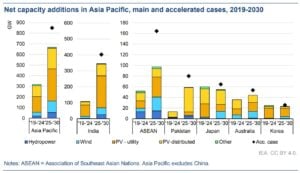
Solar energy is leading the charge. In 2024, India added more than 17 GW of solar capacity, supported by large auctions and declining costs. Wind capacity also grew modestly, and new hybrid projects combining solar and wind are improving reliability.
The government’s goal is ambitious: 500 GW of non-fossil capacity by 2030, which would cover about 50% of total power demand. India is also expanding its domestic solar manufacturing base to reduce dependence on imports.
Hydropower and bioenergy continue to play supporting roles, particularly in rural electrification. The IEA reports that renewable energy in India cuts over 250 million tonnes of CO₂ emissions each year. This makes India a major player in global emission reductions, second only to China.
However, financing and grid infrastructure remain key hurdles. The report notes that India needs annual clean energy investments of about $60–70 billion through 2030 to meet its targets.
The chart below compares renewable energy capacity in 2024 vs. 2030 projections for the four key regions, based on the IEA Renewables 2025 report.
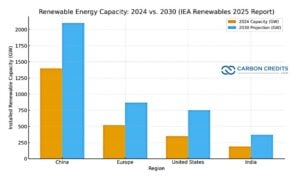
It clearly shows China’s dominant position, followed by steady growth in Europe and the U.S., and rapid expansion in India’s renewable capacity by the end of the decade.
The Decade of Clean Power: A Turning Point for Global Energy
The combined momentum of China, Europe, the United States, and India is reshaping global energy markets. Together, these four regions will account for almost 90% of all renewable capacity growth by 2030.
The pie chart shows each region’s share of total global renewable capacity additions from 2024 to 2030, based on the IEA forecast. It also shows how dominant China remains in driving renewable expansion, while Europe, the U.S., and India together account for about one-third of the world’s clean-energy growth.

Global renewable electricity capacity is expected to surpass 6,200 GW in 2025 and reach 8,300 GW by 2030 — roughly triple the total in 2015. Solar will remain the dominant source, followed by wind and hydropower.
Yet challenges persist. The IEA warns that grid constraints, permitting delays, and uneven financing could slow progress in developing economies. To stay on track for the net-zero pathway, annual renewable additions must rise to around 800 GW per year by 2030.
Still, the direction is clear. The world is entering a decade where clean power becomes the main driver of growth, investment, and energy security. The actions of these four key players will determine how fast the transition happens and how close we come to a truly sustainable global energy system.
- FURTHER READING: Renewable Energy Investment Reaches Record High as China Operates World’s Biggest Solar Farm
The post Renewables 2025: How China, the US, Europe, and India Are Leading the World’s Clean Energy Growth appeared first on Carbon Credits.
Carbon Footprint
Top Gold ETFs to Watch Now as Gold Prices Break $4,000 — IAU, GLD, and GDX Lead the Pack
Gold prices climbed to new highs on Monday, with December futures reaching a record $4,014.60 per ounce. The yellow metal stayed strong as investors sought safety amid global uncertainty and a prolonged U.S. government shutdown.
Goldman Sachs raised its December 2026 gold price forecast from $4,300 to $4,900 per ounce, citing steady central bank purchases and renewed investor interest in gold-backed ETFs. Spot gold has surged 52% so far this year, supported by a weaker U.S. dollar and rising geopolitical tensions.
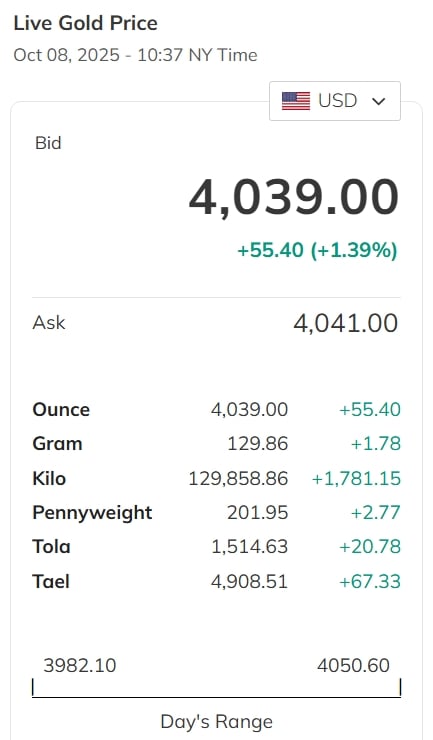
But first, let’s take a closer look at gold ETFs — what they are and why so many investors are turning to them.
What Are Gold ETFs and Why Are They Popular?
Gold Exchange-Traded Funds (ETFs) mirror the market price of physical gold without requiring investors to hold the metal themselves. Each ETF unit typically represents one gram of 99.5% pure gold, traded on stock exchanges just like shares.
Key features of gold ETFs include:
- Backed by physical gold stored in secure vaults
- Real-time pricing and easy trading through Demat accounts
- No storage or making charges
- Lower transaction costs and high liquidity
- Transparent pricing that tracks the spot gold rate
Central Banks and ETFs Fuel the Gold Price Rush
Reports say that China’s central bank has played a major role in driving gold demand. In September, the People’s Bank of China (PBOC) added to its gold reserves for the 11th month in a row, increasing holdings to 74.06 million troy ounces from 74.02 million in August. The value of these reserves also jumped to $283.29 billion, up from $253.84 billion the previous month.
Goldman Sachs expects central banks to keep buying gold, with around 80 tonnes forecast for 2025 and 70 tonnes for 2026, as emerging economies continue to diversify away from the U.S. dollar.
At the same time, strong inflows into gold ETFs are supporting the rally, giving investors an easier and safer way to gain exposure to rising gold prices.
Top Gold ETFs to Watch: IAU, GLD, and GDX
Gold ETFs provide a practical, cost-effective, and transparent way to invest in gold, avoiding the hassle of storage, insurance, and purity verification.
iShares Gold Trust (IAU)
IAU is one of the largest gold ETFs with around $72.7 billion in market capitalization. Each share represents roughly 0.01 ounces of gold, making it affordable for small investors. With a low expense ratio of 0.25%, IAU offers cost-effective access to physical gold.
However, it does not follow a specific ESG (Environmental, Social, and Governance) framework since it directly holds bullion. Any sustainability impact stems from the gold mining and refining practices behind the physical gold it stores.

SPDR Gold Shares (GLD)
GLD is the world’s largest gold ETF, managing about $129 billion in assets. Each share equals one-tenth of an ounce of gold, stored in vaults in London, New York, and Zurich, backed by custodians like JPMorgan Chase and HSBC. It is known for its high liquidity and tight spreads.
SPDR Gold Shares has removed many barriers to investing in gold, such as buying, storing, and insuring it. The fund provides direct exposure to physical gold, minus expenses, without relying on derivatives that carry extra credit risk.
It allows investors to easily access the gold market and include it in their portfolios, offering a strategic way to diversify risk due to gold’s low or negative correlation with other assets.
Like IAU, GLD does not integrate ESG criteria but depends on the ethical and environmental practices of gold suppliers and refiners.

VanEck Gold Miners ETF (GDX)
GDX differs from IAU and GLD as it invests in leading gold mining companies instead of holding physical gold. Managing around $22.54 billion in assets, GDX tracks major miners such as Newmont and Barrick Gold.
The fund provides leveraged exposure to gold prices through miner performance. Since it involves mining operations, ESG factors play a more direct role covering carbon reduction, responsible sourcing, labor safety, and community development.

Sustainability Perspective: Physical Gold vs. Gold Miners
Physical gold ETFs like IAU and GLD mainly reflect the sustainability impact of gold mining through their bullion holdings. They don’t actively engage in ESG initiatives. In contrast, GDX connects investors directly to mining companies that can influence sustainability outcomes through operational decisions.
Investors focused on responsible investing should assess the ESG performance of individual mining companies within funds like GDX. This approach allows for more transparency and accountability in evaluating how sustainable practices affect returns and risk exposure.
Gold’s Shine Isn’t Fading Anytime Soon: A Smart Safe-Haven Investment
It’s now clear that the gold price is hitting record highs due to central banks buying more, strong ETF inflows, and ongoing global uncertainty. Because of this, ETFs like IAU, GLD, and GDX give investors different ways to invest in gold, depending on their needs for liquidity, cost, and even sustainability.
At the same time, the market is watching for possible Federal Reserve rate cuts and dealing with economic uncertainty. Gold’s appeal as a safe-haven asset remains strong. And Goldman Sachs’ higher forecast adds to investor confidence — the gold story is far from over.

Also, institutional investors are increasingly using gold ETFs to balance portfolios and protect against stock market swings. Experts recommend investing gradually and diversifying, especially after gold’s sharp price jump. Long-term investors like these ETFs because they are affordable, simple, and easy to manage.
Plus, rising interest in gold is encouraging some investors to explore other commodity ETFs, such as silver and industrial metals, to spread their risk.
In short, gold ETFs are a favorite in 2025 for their simplicity, transparency, and ability to protect against inflation and market ups and downs. Both retail and institutional investors see them as a safe and reliable way to invest in uncertain times.
- READ MORE: Gold Price Today Surges to All-Time High at $3,671 as Miners Push ESG and Carbon Reduction Goals
The post Top Gold ETFs to Watch Now as Gold Prices Break $4,000 — IAU, GLD, and GDX Lead the Pack appeared first on Carbon Credits.
Carbon Footprint
Microsoft Expands Japan’s Green Grid with Shizen Energy’s 100 MW Solar Push
In October 2023, Shizen Energy Inc. signed a 20-year virtual power purchase agreement (VPPA) with Microsoft (MSFT stock) to provide renewable energy from a 25 MWac solar farm in Inuyama City, Aichi Prefecture. As with other global deals, this VPPA helped Shizen Energy secure funding for the Inuyama project.
Now the company has recently announced an expanded partnership with Microsoft. It currently has 100 MW in Renewable Energy Purchase Agreements across four solar projects in Japan.
Building on this success, Microsoft signed three additional 20-year agreements for solar plants in Kyushu and Chugoku, further advancing both companies’ renewable energy goals.
Rei Ushikubo, Executive Officer of Shizen Energy, said,
“Following the Inuyama Project, we are honored to have signed long-term agreements with Microsoft for several new projects. We believe that securing financing from domestic and international financial institutions for these projects is proof of the growing presence of Renewable Power Purchase Agreements in the Japanese market. We will continue to prioritize our power purchase agreement business to support our customers’ decarbonization efforts.”
Shizen Energy Delivers Efficiency Across Four Solar Plants
Shizen Energy has already started operations at one Kyushu plant. The remaining projects are under construction, including its site and wholly-owned EPC subsidiary, Shizen Engineering Inc. All four projects will operate under Shizen Operations Inc., which manages asset operations and maintenance.
The company is also handling project coordination, financing, and asset management, while its subsidiaries manage EPC and O&M. This integrated approach allows the company to deliver large-scale projects efficiently and reliably.
Earlier, it was revealed that the Inuyama Solar Power Plant stands as the largest single-asset solar project in Japan to reach financial close under a VPPA. The project had received ¥10.9 billion in non-recourse financing from Societe Generale, marking the first international funding for a Japanese VPPA-linked renewable project.
Inuyama City Solar Project
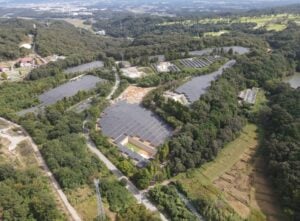
Global Expansion and Innovation
Shizen Energy aims to accelerate the global shift to renewable energy under the motto “We take action for the blue planet.” The company has expanded projects to Southeast Asia and Brazil and introduced advanced energy technologies, including microgrids, virtual power plants (VPPs), and smart EV charging systems through its proprietary EMS.
It has generated more than 1 GW of renewable energy worldwide and earned recognition as Forbes Japan’s top startup in 2024. With these milestones, the company continues to lead both domestic and international corporate renewable markets.
Boost to Microsoft’s 100% Renewable Energy Goal
This deal is Microsoft’s first renewable energy purchase in Japan. And these REPAs help Microsoft move toward 100% renewable energy for its operations by 2025.
By adding clean energy to Japan’s electricity grid, the tech giant is contributing to both corporate sustainability and grid decarbonization.
Adrian Anderson, General Manager, Renewable and Carbon Free Energy at Microsoft, had said,
“Shizen Energy’s expertise and presence in the Japanese market is enabling our first renewable energy purchase in Japan and it’s great to see near-term supply for our 100% renewable energy goal. A commercial structure like this is important to promoting grid decarbonization in the country.”
Globally, to date, Microsoft has contracted over 34 GW of renewable capacity across 24 countries, up from 1.8 GW in 2020, as highlighted in its 2025 sustainability report.
Last year, it further diversified its portfolio and added 19 GW of new renewable energy across 16 countries. Key expansions included:
-
Brookfield Renewable Energy Framework – Delivering over 10.5 GW in the U.S. and Europe over the next five years.
-
Wisconsin PPA with National Grid Renewables – A 250 MW agreement supporting a growing datacenter region, paired with a $15 million community fund for environmental resilience.
Some other global projects included a 415 MW solar facility in Germany, a 48.8 MW wind project in Ireland, and a 36 MW solar plant in Poland. These projects showcase our commitment to expanding clean energy capacity across diverse markets.
These investments allow Microsoft to expand renewable markets worldwide and support grid decarbonization in all regions where it operates.
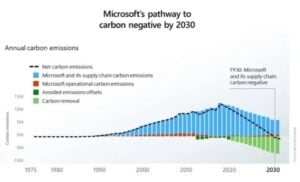
SEE MORE:
- Microsoft’s $6.2 Billion AI Bet in Norway for 100% Renewable Energy-Powered Computing
- Meta Powers U.S. Data Centers with Nearly 800 MW of Clean Energy Deal with Invenergy
- Microsoft Invests in Clearloop’s Solar Projects to Drive Grid Decarbonization in America
Japan’s Renewable Energy Outlook
Data shows that Japan aims for 36–38% renewables in its electricity mix by 2030, but slower project development and rising electricity demand keep the share below 30%. Nuclear restarts and decommissioning of old thermal plants have helped reduce emissions by nearly 5% from 2023, reaching the lowest levels since 2015.
Most significantly, agri-solar projects, combining solar generation with farmland, are emerging as a key growth area. Japan has solar potential of 1,465–2,380 GW, far above the current installed capacity of 74 GW. Interestingly, local developers are aggregating small projects and securing financing, creating scalable, sustainable solutions for corporate PPAs.
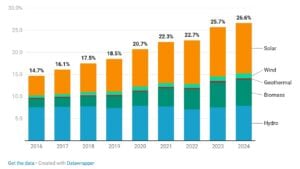
Shizen Energy’s REPAs with Microsoft show the growing impact of corporate renewable procurement. The agreements attract international financing, provide long-term revenue certainty, and accelerate renewable deployment. Corporate PPAs help companies meet energy goals while supporting broader grid decarbonization.
Shizen Energy continues to expand solar, wind, biomass, and innovative energy solutions. Its integrated development, construction, and operations model ensures projects are delivered efficiently and effectively.
Together, Microsoft and Shizen Energy are shaping Japan’s corporate renewable energy market and proving that sustainable, commercially viable solutions are achievable.
The post Microsoft Expands Japan’s Green Grid with Shizen Energy’s 100 MW Solar Push appeared first on Carbon Credits.
-
Climate Change2 years ago
Spanish-language misinformation on renewable energy spreads online, report shows
-
Climate Change2 months ago
Guest post: Why China is still building new coal – and when it might stop
-
Climate Change Videos2 years ago
The toxic gas flares fuelling Nigeria’s climate change – BBC News
-

 Greenhouse Gases1 year ago
Greenhouse Gases1 year ago嘉宾来稿:满足中国增长的用电需求 光伏加储能“比新建煤电更实惠”
-

 Climate Change1 year ago
Climate Change1 year ago嘉宾来稿:满足中国增长的用电需求 光伏加储能“比新建煤电更实惠”
-
Greenhouse Gases2 months ago
Guest post: Why China is still building new coal – and when it might stop
-

 Carbon Footprint2 years ago
Carbon Footprint2 years agoUS SEC’s Climate Disclosure Rules Spur Renewed Interest in Carbon Credits
-
Renewable Energy3 months ago
US Grid Strain, Possible Allete Sale


